Overview
- Description
- Collection of newspapers articles written and created by American journalist Albert E. Carter, who created political cartoons and wrote for the Chattanooga Times in Tennessee from circa 1930-1940. In 1934, Carter traveled to Europe for many months and detailed his experiences bicycling and traveling through Nazi Germany.
- Credit Line
- United States Holocaust Memorial Museum Collection, Gift of Sally Carter
Physical Details
- Language
- English
- Genre/Form
- Newspaper articles. Cartoons.
- Extent
-
1 box
Rights & Restrictions
- Conditions on Access
- There are no known restrictions on access to this material.
- Conditions on Use
- Material(s) in this collection may be protected by copyright and/or related rights. You do not require further permission from the Museum to use this material. The user is solely responsible for making a determination as to if and how the material may be used.
Keywords & Subjects
- Topical Term
- Travel--Germany.
Administrative Notes
- Holder of Originals
-
United States Holocaust Memorial Museum
- Legal Status
- Permanent Collection
- Provenance
- Donated to the United States Holocaust Memorial Museum in 2018 by Sally Carter.
- Record last modified:
- 2024-03-08 07:34:30
- This page:
- https://collections.ushmm.org/search/catalog/irn619028
Download & Licensing
- In Copyright - Use Permitted
- Terms of Use
- This record is not digitized and cannot be downloaded online.
In-Person Research
- Request 7 Days in Advance of Visit
- Plan a Research Visit
-
Request in Shapell Center Reading Room
Bowie, MD
Contact Us
Also in Albert E. Carter collection
The collection consists of political cartoons, a book, and newspaper articles relating to the experiences of Albert E. Carter as a journalist in the United States, Germany, and South America before and during World War II.
Date: approximately 1930-1943

Political cartoon depicting terrorism in Europe created by an American journalist
Object
Political cartoon depicting European terrorism as a giant, created by American journalist Albert E. Carter while writing for the Chattanooga Times Free Press in Tennessee, from 1930-1943. He often punctuated his articles with cartoons depicting global news and international leaders. Albert, a college senior, was working as a reporter for the Chattanooga Times when Adolf Hitler was appointed Chancellor of Germany in January 1933. During the mid-1930s, Germany followed a revisionist policy aimed at overcoming the restrictions imposed by the Treaty of Versailles (1919). These policy changes prompted foreign scholars, government officials, and reporters, like Albert, to make their way to Germany to document events. For much of 1934, Albert traveled around Germany by bike while recording his experiences. In 1936, Albert became the Sunday editor and foreign affairs columnist for the paper. Germany, Italy, the Soviet Union, and Japan frequently made international headlines in the second half of the 1930s, and all had leaders represented in Albert’s cartoons. Spurred by a growing interest in South America’s relationship to the US and events in Europe that led up to the war, Albert visited all the nations of South America as a reporter and researcher from 1940 into 1941. Albert returned to the US early in 1941, where he published “The Battle for South America” later that year. In 1943, Albert became a Foreign Service Officer serving in Central and South America for the U.S. State Department. In 1946, Albert married Dorothy Sharp Carter, an American school teacher, in Costa Rica. Dorothy and their four children accompanied Albert while he was posted at embassies throughout his career, including Uruguay, Panama, Paraguay, and Germany.
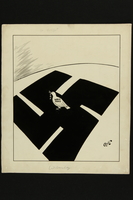
Political cartoon depicting world peace perched on a swastika created by an American journalist
Object
Political cartoon depicting world peace as a dove perched on a swastika, created by American journalist Albert E. Carter while writing for the Chattanooga Times Free Press in Tennessee, from 1930-1943. He often punctuated his articles with cartoons depicting global news and international leaders. Albert, a college senior, was working as a reporter for the Chattanooga Times when Adolf Hitler was appointed Chancellor of Germany in January 1933. During the mid-1930s, Germany followed a revisionist policy aimed at overcoming the restrictions imposed by the Treaty of Versailles (1919). These policy changes prompted foreign scholars, government officials, and reporters, like Albert, to make their way to Germany to document events. For much of 1934, Albert traveled around Germany by bike while recording his experiences. In 1936, Albert became the Sunday editor and foreign affairs columnist for the paper. Germany, Italy, the Soviet Union, and Japan frequently made international headlines in the second half of the 1930s, and all had leaders represented in Albert’s cartoons. Spurred by a growing interest in South America’s relationship to the US and events in Europe that led up to the war, Albert visited all the nations of South America as a reporter and researcher from 1940 into 1941. Albert returned to the US early in 1941, where he published “The Battle for South America” later that year. In 1943, Albert became a Foreign Service Officer serving in Central and South America for the U.S. State Department. In 1946, Albert married Dorothy Sharp Carter, an American school teacher, in Costa Rica. Dorothy and their four children accompanied Albert while he was posted at embassies throughout his career, including Uruguay, Panama, Paraguay, and Germany.
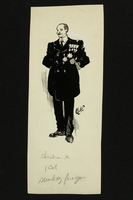
Political cartoon depicting King Christian X of Denmark created by an American journalist
Object
Political cartoon depicting King Christian X of Denmark, created by American journalist Albert E. Carter while he was the Sunday editor and foreign affairs columnist for the Chattanooga Times Free Press in Tennessee, from 1936-1943. He often punctuated his articles with cartoons depicting global news and international leaders. Albert, a college senior, was working as a reporter for the Chattanooga Times when Adolf Hitler was appointed Chancellor of Germany in January 1933. During the mid-1930s, Germany followed a revisionist policy aimed at overcoming the restrictions imposed by the Treaty of Versailles (1919). These policy changes prompted foreign scholars, government officials, and reporters, like Albert, to make their way to Germany to document events. For much of 1934, Albert traveled around Germany by bike while recording his experiences. In 1936, Albert became the Sunday editor and foreign affairs columnist for the paper. Germany, Italy, the Soviet Union, and Japan frequently made international headlines in the second half of the 1930s, and all had leaders represented in Albert’s cartoons. Spurred by a growing interest in South America’s relationship to the US and events in Europe that led up to the war, Albert visited all the nations of South America as a reporter and researcher from 1940 into 1941. Albert returned to the US early in 1941, where he published “The Battle for South America” later that year. In 1943, Albert became a Foreign Service Officer serving in Central and South America for the U.S. State Department. In 1946, Albert married Dorothy Sharp Carter, an American school teacher, in Costa Rica. Dorothy and their four children accompanied Albert while he was posted at embassies throughout his career, including Uruguay, Panama, Paraguay, and Germany.
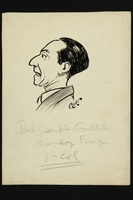
Political cartoon depicting Joseph Goebbels created by an American journalist
Object
Political cartoon depicting German Minister of Public Enlightenment and Propaganda Joseph Goebbels, created by American journalist Albert E. Carter while he was the Sunday editor and foreign affairs columnist for the Chattanooga Times Free Press in Tennessee, from 1936-1943. He often punctuated his articles with cartoons depicting global news and international leaders. Albert, a college senior, was working as a reporter for the Chattanooga Times when Adolf Hitler was appointed Chancellor of Germany in January 1933. During the mid-1930s, Germany followed a revisionist policy aimed at overcoming the restrictions imposed by the Treaty of Versailles (1919). These policy changes prompted foreign scholars, government officials, and reporters, like Albert, to make their way to Germany to document events. For much of 1934, Albert traveled around Germany by bike while recording his experiences. In 1936, Albert became the Sunday editor and foreign affairs columnist for the paper. Germany, Italy, the Soviet Union, and Japan frequently made international headlines in the second half of the 1930s, and all had leaders represented in Albert’s cartoons. Spurred by a growing interest in South America’s relationship to the US and events in Europe that led up to the war, Albert visited all the nations of South America as a reporter and researcher from 1940 into 1941. Albert returned to the US early in 1941, where he published “The Battle for South America” later that year. In 1943, Albert became a Foreign Service Officer serving in Central and South America for the U.S. State Department. In 1946, Albert married Dorothy Sharp Carter, an American school teacher, in Costa Rica. Dorothy and their four children accompanied Albert while he was posted at embassies throughout his career, including Uruguay, Panama, Paraguay, and Germany.
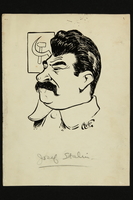
Political cartoon depicting Joseph Stalin created by an American journalist
Object
Political cartoon depicting Soviet General Secretary Joseph Stalin, created by American journalist Albert E. Carter while writing for the Chattanooga Times Free Press in Tennessee, from 1930–1943. He often punctuated his articles with cartoons depicting global news and international leaders. Albert, a college senior, was working as a reporter for the Chattanooga Times when Adolf Hitler was appointed Chancellor of Germany in January 1933. During the mid-1930s, Germany followed a revisionist policy aimed at overcoming the restrictions imposed by the Treaty of Versailles (1919). These policy changes prompted foreign scholars, government officials, and reporters, like Albert, to make their way to Germany to document events. For much of 1934, Albert traveled around Germany by bike while recording his experiences. In 1936, Albert became the Sunday editor and foreign affairs columnist for the paper. Germany, Italy, the Soviet Union, and Japan frequently made international headlines in the second half of the 1930s, and all had leaders represented in Albert’s cartoons. Spurred by a growing interest in South America’s relationship to the US and events in Europe that led up to the war, Albert visited all the nations of South America as a reporter and researcher from 1940 into 1941. Albert returned to the US early in 1941, where he published “The Battle for South America” later that year. In 1943, Albert became a Foreign Service Officer serving in Central and South America for the U.S. State Department. In 1946, Albert married Dorothy Sharp Carter, an American school teacher, in Costa Rica. Dorothy and their four children accompanied Albert while he was posted at embassies throughout his career, including Uruguay, Panama, Paraguay, and Germany.
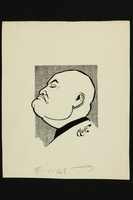
Political cartoon depicting Benito Mussolini created by an American journalist
Object
Political cartoon depicting Italian Prime Minister Benito Mussolini, created by American journalist Albert E. Carter while writing for the Chattanooga Times Free Press in Tennessee, from 1930-1943. He often punctuated his articles with cartoons depicting global news and international leaders. Albert, a college senior, was working as a reporter for the Chattanooga Times when Adolf Hitler was appointed Chancellor of Germany in January 1933. During the mid-1930s, Germany followed a revisionist policy aimed at overcoming the restrictions imposed by the Treaty of Versailles (1919). These policy changes prompted foreign scholars, government officials, and reporters, like Albert, to make their way to Germany to document events. For much of 1934, Albert traveled around Germany by bike while recording his experiences. In 1936, Albert became the Sunday editor and foreign affairs columnist for the paper. Germany, Italy, the Soviet Union, and Japan frequently made international headlines in the second half of the 1930s, and all had leaders represented in Albert’s cartoons. Spurred by a growing interest in South America’s relationship to the US and events in Europe that led up to the war, Albert visited all the nations of South America as a reporter and researcher from 1940 into 1941. Albert returned to the US early in 1941, where he published “The Battle for South America” later that year. In 1943, Albert became a Foreign Service Officer serving in Central and South America for the U.S. State Department. In 1946, Albert married Dorothy Sharp Carter, an American school teacher, in Costa Rica. Dorothy and their four children accompanied Albert while he was posted at embassies throughout his career, including Uruguay, Panama, Paraguay, and Germany.

Political cartoon depicting Éamon de Valera holding the Éire Constitution created by an American journalist
Object
Political cartoon depicting Prime Minister of Ireland Éamon de Valera, created by American journalist Albert E. Carter while he was the Sunday editor and foreign affairs columnist for the Chattanooga Times Free Press in Tennessee, from 1936-1943. He often punctuated his articles with cartoons depicting global news and international leaders. Albert, a college senior, was working as a reporter for the Chattanooga Times when Adolf Hitler was appointed Chancellor of Germany in January 1933. During the mid-1930s, Germany followed a revisionist policy aimed at overcoming the restrictions imposed by the Treaty of Versailles (1919). These policy changes prompted foreign scholars, government officials, and reporters, like Albert, to make their way to Germany to document events. For much of 1934, Albert traveled around Germany by bike while recording his experiences. In 1936, Albert became the Sunday editor and foreign affairs columnist for the paper. Germany, Italy, the Soviet Union, and Japan frequently made international headlines in the second half of the 1930s, and all had leaders represented in Albert’s cartoons. Spurred by a growing interest in South America’s relationship to the US and events in Europe that led up to the war, Albert visited all the nations of South America as a reporter and researcher from 1940 into 1941. Albert returned to the US early in 1941, where he published “The Battle for South America” later that year. In 1943, Albert became a Foreign Service Officer serving in Central and South America for the U.S. State Department. In 1946, Albert married Dorothy Sharp Carter, an American school teacher, in Costa Rica. Dorothy and their four children accompanied Albert while he was posted at embassies throughout his career, including Uruguay, Panama, Paraguay, and Germany.
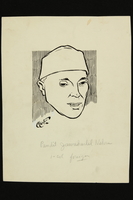
Political cartoon depicting Jawaharlal Nehru created by an American journalist
Object
Political cartoon depicting Indian politician and supporter of independence Jawaharlal Nehru, created by American journalist Albert E. Carter while he was the Sunday editor and foreign affairs columnist for the Chattanooga Times Free Press in Tennessee, from 1936-1943. He often punctuated his articles with cartoons depicting global news and international leaders. Albert, a college senior, was working as a reporter for the Chattanooga Times when Adolf Hitler was appointed Chancellor of Germany in January 1933. During the mid-1930s, Germany followed a revisionist policy aimed at overcoming the restrictions imposed by the Treaty of Versailles (1919). These policy changes prompted foreign scholars, government officials, and reporters, like Albert, to make their way to Germany to document events. For much of 1934, Albert traveled around Germany by bike while recording his experiences. In 1936, Albert became the Sunday editor and foreign affairs columnist for the paper. Germany, Italy, the Soviet Union, and Japan frequently made international headlines in the second half of the 1930s, and all had leaders represented in Albert’s cartoons. Spurred by a growing interest in South America’s relationship to the US and events in Europe that led up to the war, Albert visited all the nations of South America as a reporter and researcher from 1940 into 1941. Albert returned to the US early in 1941, where he published “The Battle for South America” later that year. In 1943, Albert became a Foreign Service Officer serving in Central and South America for the U.S. State Department. In 1946, Albert married Dorothy Sharp Carter, an American school teacher, in Costa Rica. Dorothy and their four children accompanied Albert while he was posted at embassies throughout his career, including Uruguay, Panama, Paraguay, and Germany.

Political cartoon depicting Chiang Kai-shek created by an American journalist
Object
Political cartoon depicting Chinese Chairman of the Military Affairs Commission Chiang Kai-shek, created by American journalist Albert E. Carter while he was the Sunday editor and foreign affairs columnist for the Chattanooga Times Free Press in Tennessee, from 1936-1943. He often punctuated his articles with cartoons depicting global news and international leaders. Albert, a college senior, was working as a reporter for the Chattanooga Times when Adolf Hitler was appointed Chancellor of Germany in January 1933. During the mid-1930s, Germany followed a revisionist policy aimed at overcoming the restrictions imposed by the Treaty of Versailles (1919). These policy changes prompted foreign scholars, government officials, and reporters, like Albert, to make their way to Germany to document events. For much of 1934, Albert traveled around Germany by bike while recording his experiences. In 1936, Albert became the Sunday editor and foreign affairs columnist for the paper. Germany, Italy, the Soviet Union, and Japan frequently made international headlines in the second half of the 1930s, and all had leaders represented in Albert’s cartoons. Spurred by a growing interest in South America’s relationship to the US and events in Europe that led up to the war, Albert visited all the nations of South America as a reporter and researcher from 1940 into 1941. Albert returned to the US early in 1941, where he published “The Battle for South America” later that year. In 1943, Albert became a Foreign Service Officer serving in Central and South America for the U.S. State Department. In 1946, Albert married Dorothy Sharp Carter, an American school teacher, in Costa Rica. Dorothy and their four children accompanied Albert while he was posted at embassies throughout his career, including Uruguay, Panama, Paraguay, and Germany.

Political cartoon depicting Agustín Justo created by an American journalist
Object
Political cartoon depicting Argentinian President Agustín Justo (1932-1938), created by American journalist Albert E. Carter while he was the Sunday editor and foreign affairs columnist for the Chattanooga Times Free Press in Tennessee, from 1936-1943. He often punctuated his articles with cartoons depicting global news and international leaders. Albert, a college senior, was working as a reporter for the Chattanooga Times when Adolf Hitler was appointed Chancellor of Germany in January 1933. During the mid-1930s, Germany followed a revisionist policy aimed at overcoming the restrictions imposed by the Treaty of Versailles (1919). These policy changes prompted foreign scholars, government officials, and reporters, like Albert, to make their way to Germany to document events. For much of 1934, Albert traveled around Germany by bike while recording his experiences. In 1936, Albert became the Sunday editor and foreign affairs columnist for the paper. Germany, Italy, the Soviet Union, and Japan frequently made international headlines in the second half of the 1930s, and all had leaders represented in Albert’s cartoons. Spurred by a growing interest in South America’s relationship to the US and events in Europe that led up to the war, Albert visited all the nations of South America as a reporter and researcher from 1940 into 1941. Albert returned to the US early in 1941, where he published “The Battle for South America” later that year. In 1943, Albert became a Foreign Service Officer serving in Central and South America for the U.S. State Department. In 1946, Albert married Dorothy Sharp Carter, an American school teacher, in Costa Rica. Dorothy and their four children accompanied Albert while he was posted at embassies throughout his career, including Uruguay, Panama, Paraguay, and Germany.

Political cartoon depicting Prince Saionji Kinmochi created by an American journalist
Object
Political cartoon depicting former Japanese Prime Minister and the nation’s last elder statesman, Prince Saionji Kinmochi, created by American journalist Albert E. Carter while he was the Sunday editor and foreign affairs columnist for the Chattanooga Times Free Press in Tennessee, from 1936-1943. He often punctuated his articles with cartoons depicting global news and international leaders. Albert, a college senior, was working as a reporter for the Chattanooga Times when Adolf Hitler was appointed Chancellor of Germany in January 1933. During the mid-1930s, Germany followed a revisionist policy aimed at overcoming the restrictions imposed by the Treaty of Versailles (1919). These policy changes prompted foreign scholars, government officials, and reporters, like Albert, to make their way to Germany to document events. For much of 1934, Albert traveled around Germany by bike while recording his experiences. In 1936, Albert became the Sunday editor and foreign affairs columnist for the paper. Germany, Italy, the Soviet Union, and Japan frequently made international headlines in the second half of the 1930s, and all had leaders represented in Albert’s cartoons. Spurred by a growing interest in South America’s relationship to the US and events in Europe that led up to the war, Albert visited all the nations of South America as a reporter and researcher from 1940 into 1941. Albert returned to the US early in 1941, where he published “The Battle for South America” later that year. In 1943, Albert became a Foreign Service Officer serving in Central and South America for the U.S. State Department. In 1946, Albert married Dorothy Sharp Carter, an American school teacher, in Costa Rica. Dorothy and their four children accompanied Albert while he was posted at embassies throughout his career, including Uruguay, Panama, Paraguay, and Germany.
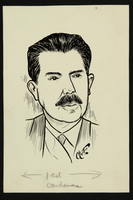
Political cartoon depicting Lázaro Cárdenas created by an American journalist
Object
Political cartoon depicting Mexican President Lázaro Cárdenas, created by American journalist Albert E. Carter while writing for the Chattanooga Times Free Press in Tennessee, from 1930-1943. He often punctuated his articles with cartoons depicting global news and international leaders. Albert, a college senior, was working as a reporter for the Chattanooga Times when Adolf Hitler was appointed Chancellor of Germany in January 1933. During the mid-1930s, Germany followed a revisionist policy aimed at overcoming the restrictions imposed by the Treaty of Versailles (1919). These policy changes prompted foreign scholars, government officials, and reporters, like Albert, to make their way to Germany to document events. For much of 1934, Albert traveled around Germany by bike while recording his experiences. In 1936, Albert became the Sunday editor and foreign affairs columnist for the paper. Germany, Italy, the Soviet Union, and Japan frequently made international headlines in the second half of the 1930s, and all had leaders represented in Albert’s cartoons. Spurred by a growing interest in South America’s relationship to the US and events in Europe that led up to the war, Albert visited all the nations of South America as a reporter and researcher from 1940 into 1941. Albert returned to the US early in 1941, where he published “The Battle for South America” later that year. In 1943, Albert became a Foreign Service Officer serving in Central and South America for the U.S. State Department. In 1946, Albert married Dorothy Sharp Carter, an American school teacher, in Costa Rica. Dorothy and their four children accompanied Albert while he was posted at embassies throughout his career, including Uruguay, Panama, Paraguay, and Germany.

Political cartoon depicting Maksim Litvinov created by an American journalist
Object
Political cartoon depicting Soviet Commissar for Foreign Affairs Maksim Litvinov, created by American journalist Albert E. Carter while writing for the Chattanooga Times Free Press in Tennessee, from 1930-1943. He often punctuated his articles with cartoons depicting global news and international leaders. Albert, a college senior, was working as a reporter for the Chattanooga Times when Adolf Hitler was appointed Chancellor of Germany in January 1933. During the mid-1930s, Germany followed a revisionist policy aimed at overcoming the restrictions imposed by the Treaty of Versailles (1919). These policy changes prompted foreign scholars, government officials, and reporters, like Albert, to make their way to Germany to document events. For much of 1934, Albert traveled around Germany by bike while recording his experiences. In 1936, Albert became the Sunday editor and foreign affairs columnist for the paper. Germany, Italy, the Soviet Union, and Japan frequently made international headlines in the second half of the 1930s, and all had leaders represented in Albert’s cartoons. Spurred by a growing interest in South America’s relationship to the US and events in Europe that led up to the war, Albert visited all the nations of South America as a reporter and researcher from 1940 into 1941. Albert returned to the US early in 1941, where he published “The Battle for South America” later that year. In 1943, Albert became a Foreign Service Officer serving in Central and South America for the U.S. State Department. In 1946, Albert married Dorothy Sharp Carter, an American school teacher, in Costa Rica. Dorothy and their four children accompanied Albert while he was posted at embassies throughout his career, including Uruguay, Panama, Paraguay, and Germany.



